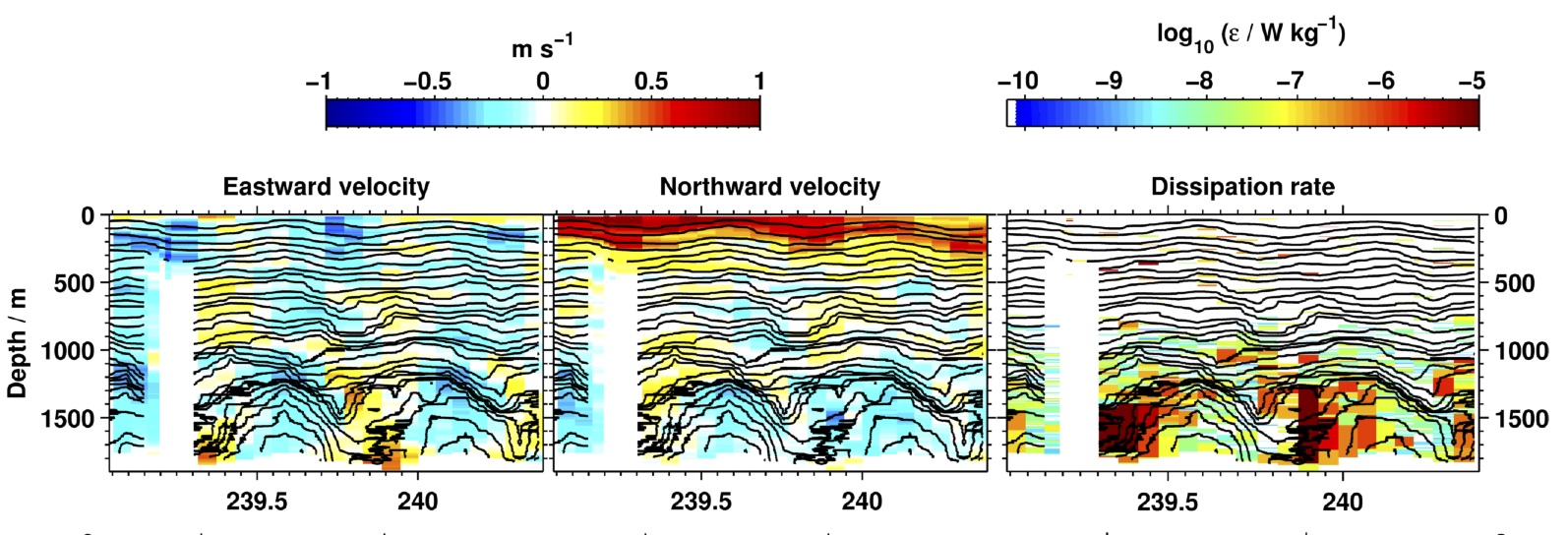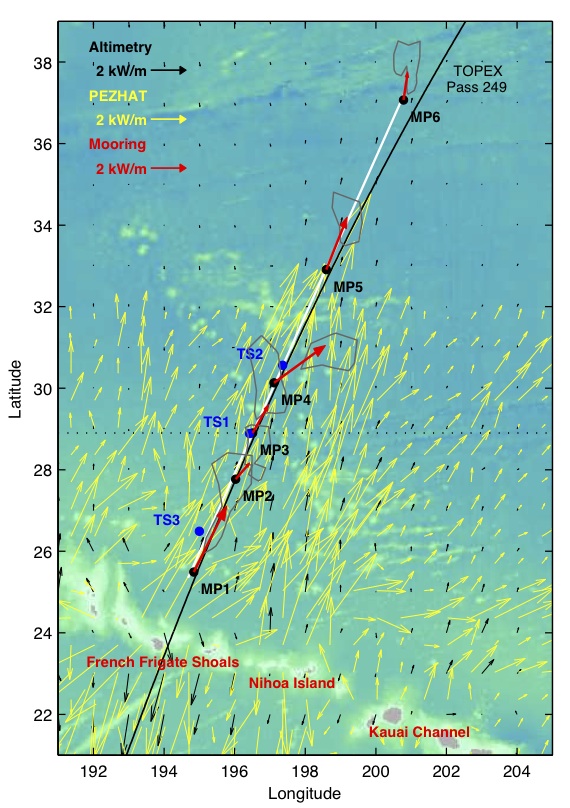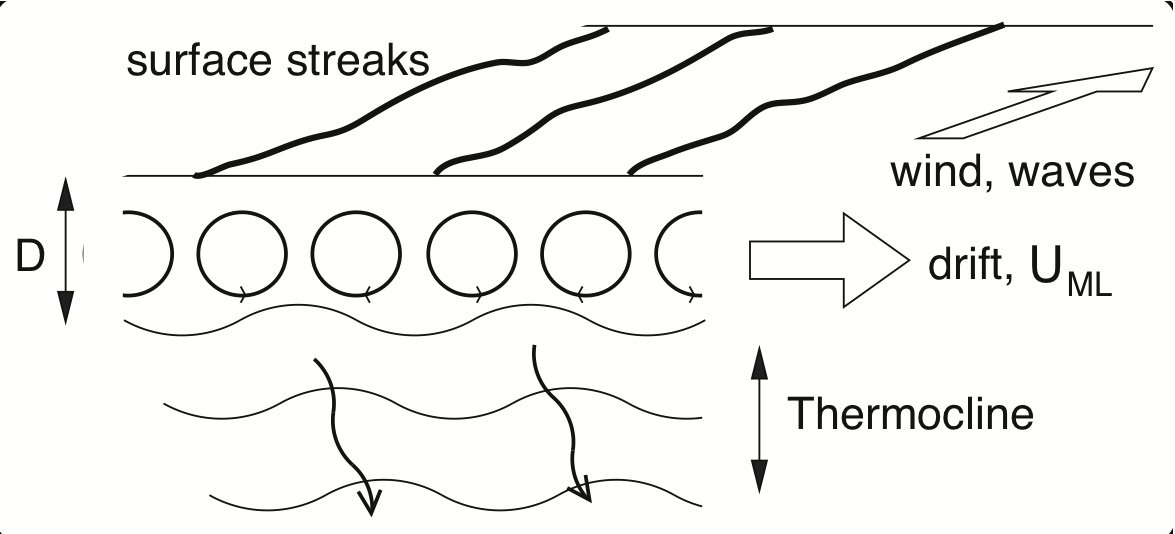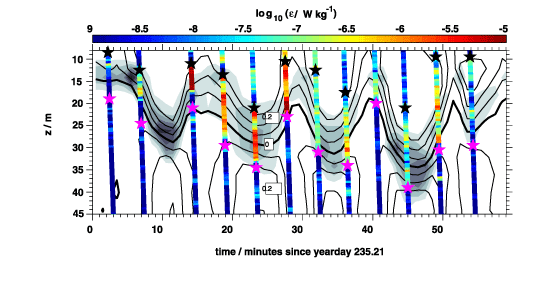Research
Climate Process Team: incorporating internal-wave driven mixing into global climate models
I'm leading a group of 20 PIs in a multi-year project aimed at developing better parameterizations of mixing for use in global models. Most large-scale models use only a simplistic representation of diapcynal mixing in the stratified ocean, whereas observations clearly show mixing varies enormously in time and space. The variability is largely due to dynamics and geography of internal wave generation, proapgation, and dissipation. Preliminary simulations show that global models are sensitive to the distribution of mixing, so getting that pattern "right" is essential for proper modeling of past and future climates. Over the next 3-5 years our team will combine observations, theory and numical process studies to develop a way to represent the magnitude and variabiltiy of turbulent mixing. For more details see the project webpage.
Air-Sea Interaction Research Initiative (ASIRI)
This 5-year ONR-sponsored project has the overall goal of developing accurate representations of upper ocean mixing in the Bay of Bengal, and subsequently improving regional air-sea interaction models and Monsoon prediction models. Initial descriptions may be found here and here.
Turbulent fluxes in the Arctic Ocean
Accurate
measurements and ultimately predictions of turbulent salt and heat
fluxes in the upper Arctic
Ocean are essential to make sense of a changing climate. The Beaufort
Gyre (BG) is historically home to some
of the oldest and thickest ice in the Arctic, but is now remarkably ice
free in summer. Large areas of ocean are
now exposed to direct wind forcing. Turbulence directly forced by
surface wind stress is confined to a shallow
mixed layer. However, wind stress also generates near-inertial internal
waves (NIW) that can propagate
downwards into stratified water and break hundreds of meters or more
below the surface. Crucially, mixing in
this depth range can tap into the large heat reservoir of
Atlantic-origin water. Increased turbulent heat fluxes
up from this water mass could significantly warm the upper ocean and
accelerate ice loss. Understanding of
this process has been hampered in large part by a lack of detailed
measurements of turbulent mixing rates
below the surface mixed layer, especially in open water where NIW are
expected to be strong.
In September 2015 we will embark on a research expedition onboard the R/V Sikuliaq to measure turbulent mixing rates in the upper ocean in the Beaufort Sea. Watch this space for results!
In September 2015 we will embark on a research expedition onboard the R/V Sikuliaq to measure turbulent mixing rates in the upper ocean in the Beaufort Sea. Watch this space for results!
Internal Waves in Straits Experiment (IWISE)
Some of the largest internal tides in the world are generated in Luzon Strait, between Taiwan and the Phillipines. A series of recent ONR-funded projects has been tasked with understanding the generation of these waves and their evolution into strongly nonlinear solitons observed further to the west. Preliminary fieldwork in August 2010 focused on wave generation near the two-ridge system of Luzon. We measured some of the strongest fluxes and largest turbulent overturns ever observed - an example of the later is shown below. Future fieldwork will be conducted in summer 2011.
 |
Caption: Time
series of eastward (left) and northward (middle) velocity, and
turbulent dissipation rate (right) for a Lowered ADCP station near the
ridge-top in Luzon Strait. Superimposed are density contours
(black lines) are evenly spaced in the resting depth of each
isopycnal. The figure shows strong bottom-intensified isopycnal
displacements twice a day, consistent with a semidirunal internal
tide. Associated with these motions are large (hundreds of
meters) static instabilities and some of the largest turbulent
dissipation rates measured in the deep ocean. [Alford et al 2011]. |
Mixing near the SW Indian Ridge
Small-scale processes in the Indian Ocean are vastly undersampled. Preliminary evidence suggests the rough topography of the western Indian Ocean basin may lead to enhanced mixing through a variety of mechanisms. In 2007/08 we conducted fieldwork over the SW Indian Ridge, jointly funded by NSF and the University of California ship funds program. Our project had two components. First, we got a quick glimpse of a strong (3 Sv) river of deep and bottom water flowing equatorwards through the Atlantis II fracture zone, one of the deepest gaps in the ridge. The flow is likely a significant component of the basin total overturning ciruclation. It was highly turbulent, potentially producing significant water mass modification en route. Future work will hopefully allow us to return to the site to properly document the mangnitude, variability and dynamics of this flow.
Second, a strong internal tide was also observed radiating upwards from the rough topography of the ridge. The tide had relatively small vertical scales and was often focused into coherent beams. Such high-mode tides may lead to elevated mixing along the entire legnth of the SW Indian Ridge. Graduate student Tamara Beitzel is working on these results for her doctoral thesis.
Numerical Simulations of nonlinear internal-wave interactions
Turbulent mixing in the ocean is intricately related to the rate at which energy cascades from large-scale internal waves through an internal-wave continuum to the small-scale waves that break. Idealized numerical simulations are a great tool for exploring the nonlinear internal wave dynamics responsible for these energy transfers. In collaboration with Kraig Winters (SIO), I've conducted a variety of experiments over the last few years. One set has focused on energy loss by a propagating low-mode internal wave (for example an internal tide) to smaller-scale waves of near half the frequency, a process known as Parameteric Subharmonic Instability (PSI). Results like the figure below inspired the IWAP field campaign, providing a nice example of the synergies possible between numerical and observational work.
Caption: idealized numerical simulation of a mode-one internal tide propagating northward on a beta plane. The top panel shows northward velocity. When the wave reaches a critical latitude of 29N, it succumbs to parameteric subharmonic instability, with energy lost to smaller-scale motions with half the frequency (bottom panel). As a result there is elevated dissipation at and equatorward of this latitude (middle panel). [MacKinnon and Winters 2005] |
 |
More generally, we'd like to be able to predict the rate that low-mode propagating internal waves lose energy to smaller-scale waves and eventually dissiaption. My thesis work with Mike Gregg showed that the scaling relating wave energy level and associated dissipation rate was fundamentally different in shallow coastal waters than in the deep ocean. We hypotehsized that this difference was related to either the lower vertical bandwidth available for coastal internal waves or the more variable nature of the wave climate. Recently I've been following up on this idea with a series of ONR-funded simulations to understand how internal wave decay depends on such paramters. Preliminary results suggest that the scaling is different
Internal Waves Across the Pacific (IWAP)
 |
In the spring of 2006 we
conducted an experiment to follow the internal tide as it propagated
northward from generation at the Hawaiian Ride. In part, the
experiment was designed to test the hypothesis that the propagating
tide would lose significant energy through parametric subharmonic
instability (PSI), particularly near a critical latitude of 29 N.
Observational results indicate that that (i) PSI occurs in the ocean
with sufficient intensity to fundamentally alter the ocean internal
wave field at and equatorward of the critical latitude, but (ii)
appears not to represent a significant energy sink for the internal
tide. Publications: MacKinnon et al 11a and 11b Zhao et al 10 Alford et al 07 MacKinnon and Winters 05 Figure caption: A synthesized picture of the internal tide propagating north from Hawaii. Bathymetry (colors), IWAP measurement locations (black, moorings; blue, shipboard time series; white, ship track), and internal-tide energy fluxes (yellow, PEZHAT numerical model, courtesy of E. Zaron; black, altimetry from RC01 provided by R. Ray; red, moorings). Note the model’s domain ends at 32°N. Reference arrows are at upper left; the critical latitude, 28.8°N, is indicated with a dotted line. Gray curves enclose the most likely 50\pct of observed flux values. |
High-frequency internal waves in the upper ocean
| Recent observations show
evidence of high-frequency (N/2 or
higher) internal waves propagating downwards beneath the surface mixed
layer, particularly in equatorial regions. Such waves are likely
forced by motions in and at the base of the mixed layer, in particular
Langmuir cells or convectively driven mixed-layer turbulence. Two
previous NSF-funded post-docs working with Jerry Smith and myself
conducted numerical simulations looking at internal waves generated by
Langmuir cells. These waves may be an
important source of mixing
in the stratified transition zone, which in turn is vital for
regulating exchange of heat, dissolved gasses, and nutrients between
the surface and deep ocean.
More recent and ongoing work by graduate student San Nguyen and
post-doc Tycho Huussen is expanding the simulations to include
convective mixed-layer forcing (in collaboration with Ren-Chieh Lien,
UW) and searching for evidence of such waves in a variety of historical
datasets. Publications: |
 Caption: Schematic of proposed interaction mechanism. Surface winds set up coherent Langmuir cells, which perturb the mixed-layer base. The entire mixed-layer is advected by inertial motions, which in effect drags the corrugated mixed-layer based over the stratified water beneath, creating internal waves that radiate downward. Courtesy of Jeff Polton. |
Coastal
Mixing
and
Optics
Experiment
| My thesis work with Mike
Gregg explored the magnitude and mechanisms of
turbulent mixing on the New England shelf. Data was collected in
two
cruises in the summer of 1996 and the spring of 1997. Results
showed
clear delineationg of mixing in surface and bottom boundary layers,
driven by boundary friction and wind mixing, and that in the stratified
region in between, driven by internal wave breaking. In the
summer,
over half of the internal wave induced mixing was associated with the
passage of episodic strongly nonlinear solitons, like the example
pictured at right. Publications: MacKinnon and Gregg 03a and 03b MacKinnon and Gregg 05a and 05b |
 Figure Caption: The solid lines are contours of northward (on-shelf) baroclinic velocity from -0.3 to 0.3 m/s in intervals of 0.1 m/s. The shaded areas are 4-m shear variance, ranging from 0 (white) to 3.5e-3 s^{-2} (black) in increments of 5e-4 s^{-2}. Profiles of dissipation rate are overlain, and correspond to the colorbar above. The slight slant of each profile represents the passage of time as the profiler descends. The black (upper) and magenta (lower) stars on each profile indicate the evolving locations of the 22.65 and 24 isopycnals, respectively. |